History in Namibia (Afrikaans)
|
Breed Fact: Calves are small enough to be born easily, full of hardy breed characteristics and growth potential that produces heavier weaning weights, up to 30kg heavier, depending on dam, Rapid post weaning gains ability and a high degree of carcass acceptability. 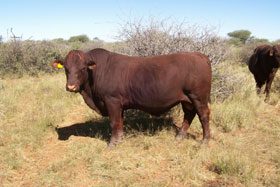
|
Die eerste Santa Gertrudis-beeste het gedurende 1964 in die destydse Suidwes-Afrika aangekom. Dit was die 23 verse en koeie en die twee bulle wat van die Mara-proefplaas na die Omatjenne-proefplaas naby Otjiwarongo oorgeplaas is. Onder die koeie was sewe van die oorspronklike ingevoerde diere. Die insluiting van die Santa Gertrudis-ras in die bekende Omatjenne-vergelykende ras-proef, destyds onder die bekwame bestuur van mnr R. Borstlap, het grootliks bygedra tot die suksesvolle ontwikkeling van die ras in Namibia, asook tot die ras se oorlewing en die sukses daarvan in Suidelike Afrika.
Tydens 'n landwye inspeksietoer deur die hele Suidelike Afrika is 'n volledige opname onder alle tellers gemaak, onder meer ook na die rede waarom hulle met die nuwe ras begin teel het. Die opname het getoon dat 26% van die tellers die resultate van die beeste by Omatjenne gesien het, en genoeg daardeur beïndruk was om self daarmee te begin teel.
Gedurende September 1967 was mnr Mieta Louw, toe nog die Hoof van Navorsing en Inligting van Suidwes-Afrika, en mnr Rudo Winckler, hoofbestuurder van die FCU-koöperasie, saam met vier karakoelboere na die VSA. Die hulp van die Santa Gertrudis Breeders International (S.G.B.I.) is ingeroep en hulle is in staat gestel om in Dallas, Texas, na ongeveer dertig Santa-bulle te kyk. Mnr Lou whet vir Omatjenne 'n bul met die nommer 296 van Allan Anderson van Frisco, Texas, gekoop, terwyl mnr Winckler so getref was deur die ras dat hy 'n bul genaamd Pedro van Byrd Cattle Co gekoop het sonder dat hy in daardie stadium 'n plaas besit het.
Die bulle het in Desember 1967 in Kaapstad aangekom en is ná een maand kwarantyn na hul eienaars vervoer. Mnr Winckler het met 'n vriend, mnr Pietie Weilbach van Omapiu by Omaruru, 'n maatskappy laat registreer en hulle het gedurende September 1968 tien verse, wat deur S.G.B.I. uitgesoek was (van Winrock, El Colina, Twin Oaks, e.a.) deur die Walvisbaai-kwarantynstasie ingevoer. 'n Ander vroeë invoerder van die ras is mnr E.L. Botha van Tokai naby Otjiwarongo. Hy het by die Imperial Cold Storages se SANBRA Charlim-inseminasie-plaas 'n King Ranch-geteelde bul ingevoer, wat in Junie 1968 by hom op die plaas aangekom het. Gedurende Mei 1968 het hy van mnr C.R. (Roly) Taylor van Tugela Estates, Colenso, twee 1963-ingevoerde koeie en self-geteelde verse gekoop. Ook mnre Weilbach en Winckler het van mnr Taylor koeie gedurende Mei 1968 van die 1963-invoer gekoop. Die Winckler/Weilbach-stoet is gedurende 1971 weens die swak gesondheid van mnr Weilbach verkoop. Baie van die diere is deur mnr E.L. Botha gekoop.
|
Breed Origin: The Santa Gertrudis breed was developed for reasons that any businessman can understand - ECONOMICS. During the late 19th and 20th centuries, King Ranch introduced purebred Hereford and Shorthorn cattle onto their, then harsh ranches. This proved to be unprofitable as these breeds could not stand the heat and diseases of South Texas. 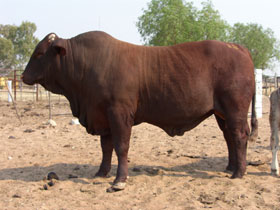
|
Mnr Murray het vir 'n Siud-Afrikaanse teller verskeie beeste gekoop, asook 'n bul en 'n vers vir mnr E Botha. Mnr H.R. Schneider-Waterberg het by die geleentheid sy eerste 17 bulle en verse gekoop. (Tot en met 1975 voer hy 'n total van 57 bulle en 28 verse in.) Die beeste bestem vir Namibia is almal na Walvisbaai verskkep en op 18 Oktober 1968 kom 22 Santa-bulle en twaalf verse met die Tyson Lykes op Walvisbaai aan - die diere van mnre Borstlap, Botha, Kollmitz en Schneider-Waterberg. Die waarde van die rand was destyds VSA-dollar 1.50 ( vyf maal hoer as nou) en die koste van die invore het goed vergelyk met stoetveepryse in die land.
Ander vroeë invoerders - tot die jaar 1972 - was mnre D.H. Botha (Oom Ouboet), J M de Wet van Outjo, K. Schmerenbeck van Windhoek, asook mnre Leicht, Martens en S J Venter van Otjiwarongo. Deur die jare tot en met 1975 toe invoere vanweë die invoerbeperkinge op stoetvee en dalende randwaarde feitlik gestaak is, het daar, afgesien van die Omatjenne-kuddes, oor die sewentig bulle en byna tagtig vroulike diere Namibia uit die VSA bereik. Die drie oudste kuddes wat vandag nog in Namibia bestaan, is dié van mnre E L Botha van Tokai, Schneider-Waterberg en B von Freier (Schmerenbeck, 1969).
Taken from AgriForum April 1997
Performance Testing

The Santa Gertrudis Society recommends performance testing. The breed perform above average in all aspects for which are tested.
1. Feed Conversion
Since the Phase C test period was reduced to 84 days, the Santa proves himself as a leader to breed better feed conversion on the veldt. Many of our growth test bulls are consuming less than 5kg of feed for 1 kg of weight gain.
2. Weaners
Santa Gertrudis weaners, purebred and crosses, consistently excel in feedlot growth test. Calves wean 20 to 30 kg more than most beef breeds and a weight gain of up to 2kg per day in feedlots are common. They are sought after because if their high cut ability (slaughter % with up to 65% having been recorded).
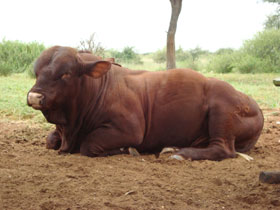 THE BLUP COMMANDMENTS (Mr CP Massmann)
THE BLUP COMMANDMENTS (Mr CP Massmann)Breeding values are obtained from information provided by breeders. The breeder won`t be able to attach much value to the breeding values if the information is inaccurate.
- Be honest with the pedigree and performance information you provide.
- Do not guess: Less abnormal or standard birth weights and/or calving codes for calves are easily traced and ejected by the computer.
- Don`t blame BLUP for your mistakes: Animals that are treated different (show cow, sick cow), must be classified in another management group.
- Large groups: Weigh all calves of the same sex on the same day.
- Calving seasons are an advantage to the breeder, animal, herd, sandex, blup and office.
- Selective measuring taboo.
- Don`t discriminate: Notify all calves in full( also culled cavles).
- Input-output conversion stays important. Weigh the Mother (for mature mass breeding value) and Calf (for wean/milk breeding value) at weaning.
- Genetic Relationship with other herds is important and therefore the exchanging of bulls, semen and the use of AI bulls, is strongly recommended.
- Help the breed then the breed will help you. The more weigh information there is on the breed the more accurate the breeding values.
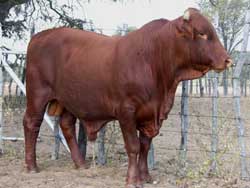 The Experts on BLUP
The Experts on BLUP- For both commercial and pedigree breeders, Blup is a major breakthrough, giving them more reliable information to compare bulls across the whole breed to produce the type of stock required.(E Peterson)
- Of all the livestock evaluation techniques available, Blup is the most accurate because it uses all of the available information on performance of the animal and its relatives, to build up a picture of the genes the animal carries and hence the likely performance of its offspring. (R Simms)
- Blup is universally recognized as being the most appropriate procedure for utilizing performance recods and is more likely to rank animals correctly in terms of true genetic merit than any other method available. (Rory Gibson)
Crossbreeding
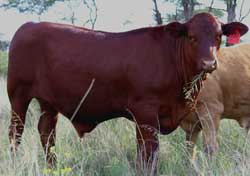 In the stud industry the biggest problem is that breeders
forget what the cattle industry is about, namely the
requirements of the commercial breeder. Commercial breeders
attend auctions and tend to buy the cheapest bull on sale,
no matter what breed it is, it is going to be the new bull/
breed in his crossbreeding programme.
In the stud industry the biggest problem is that breeders
forget what the cattle industry is about, namely the
requirements of the commercial breeder. Commercial breeders
attend auctions and tend to buy the cheapest bull on sale,
no matter what breed it is, it is going to be the new bull/
breed in his crossbreeding programme.What we should be striving for is to be producing the biggest amount of saleable beef from the grass growing on the farm. To achieve this goal, we must breed cattle that will maintain high standard in the following production characteristics: fertility, milk production, vitality, weight gain, length, muscling and temperament. Cattle must also posses constitution, of which the Santa Gertrudis breed has ample.
Characteristics with a low heritability, e.g. fertility, the most important characteristic of breed production, cannot be improved upon quickly by selection, but can be greatly enhanced by using Santa Gertrudis bulls in the crossbreeding programme.
Mortality goes hand in hand with fertility. Santa Gertrudis cows have a very low calf mortality rate and are renown for producing calves up to 16 years of age.
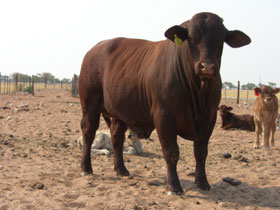 Milk production is just as important. The commercial breeder
cannot afford to try and rectify this characteristic by
selection alone when he can do so by using another breed. It
is properly the highest single factor that will determine how
many kilograms of beef a cow will produce over twelve months,
because milk is food. In the case of weaner calf producer, the
weaning weight produced by the breeding cows per hectare is the
correct measurement to use.
Milk production is just as important. The commercial breeder
cannot afford to try and rectify this characteristic by
selection alone when he can do so by using another breed. It
is properly the highest single factor that will determine how
many kilograms of beef a cow will produce over twelve months,
because milk is food. In the case of weaner calf producer, the
weaning weight produced by the breeding cows per hectare is the
correct measurement to use.
Fertility is very important. It is the very important that one`s cows are highly fertile.
With crossbreeding you can find the desired combination to suite your conditions and production system. The bigger the genetic variation between breeds, the better the hybrid vigour.
In extensive conditions the best results of crossbreeding will be achieved by crossing an European breed (Bos Taurus) with a Zebo (Bos Indicus) breed or a developed breed such as the Santa Gertrudis.
Hybrid vigour is not heritable. To maintain this, the crossbreeding programme must be correctly managed. In any crossbreeding system selection with performance and conformation in mind, is just as important as in stud breeding.
Thus, one of the most important aspects in a crossbreeding programme is the bull in use. The purchase of a bull is an investment. The influence of the last three bulls you bought into the herd is nearly 90%. The long term effect of a good or poor bull in the future herd is therefore clearly noticeable.
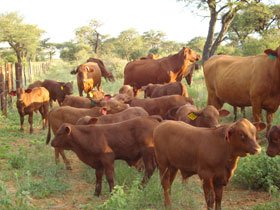 Ask yourself the following question:
Ask yourself the following question:
- What natural feed resources are available?
- What cultivated fodder is economically available?
- Based in feed resources, what system of production (weaner, yearling, long yearling, oxen off the veldt or feed lotting) is the most profitable?
- Finally and most importantly, do I like the breed?
By using a Santa Gertrudis bull, you can of course need only concentrate on the one breed because the pure Santa gertrudis weighs as much at 18 months as other breeds with the advantage of crossbred hybrid vigour. You have the added advantage of having an uniform cherry red herd.
In conclusion the following:
If you use Santa Gertrudis bulls, you can have confidence in your product.

 @santagertrudisnamibia
@santagertrudisnamibia